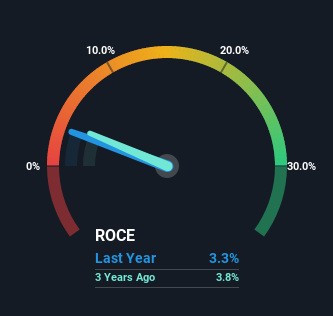HealthStream (NASDAQ:HSTM) Has More To Do To Multiply In Value Going Forward
There are a few key trends to look for if we want to identify the next multi-bagger. Firstly, we'd want to identify a growing return on capital employed (ROCE) and then alongside that, an ever-increasing base of capital employed. Basically this means that a company has profitable initiatives that it can continue to reinvest in, which is a trait of a compounding machine. However, after investigating HealthStream (NASDAQ:HSTM), we don't think it's current trends fit the mold of a multi-bagger.
Return On Capital Employed (ROCE): What Is It?
Just to clarify if you're unsure, ROCE is a metric for evaluating how much pre-tax income (in percentage terms) a company earns on the capital invested in its business. The formula for this calculation on HealthStream is:
Return on Capital Employed = Earnings Before Interest and Tax (EBIT) ÷ (Total Assets - Current Liabilities)
0.033 = US$12m ÷ (US$498m - US$117m) (Based on the trailing twelve months to December 2022).
So, HealthStream has an ROCE of 3.3%. Ultimately, that's a low return and it under-performs the Healthcare Services industry average of 5.9%.
View our latest analysis for HealthStream
Above you can see how the current ROCE for HealthStream compares to its prior returns on capital, but there's only so much you can tell from the past. If you'd like, you can check out the forecasts from the analysts covering HealthStream here for free.
What Does the ROCE Trend For HealthStream Tell Us?
The returns on capital haven't changed much for HealthStream in recent years. The company has employed 23% more capital in the last five years, and the returns on that capital have remained stable at 3.3%. This poor ROCE doesn't inspire confidence right now, and with the increase in capital employed, it's evident that the business isn't deploying the funds into high return investments.
The Bottom Line On HealthStream's ROCE
As we've seen above, HealthStream's returns on capital haven't increased but it is reinvesting in the business. And with the stock having returned a mere 11% in the last five years to shareholders, you could argue that they're aware of these lackluster trends. As a result, if you're hunting for a multi-bagger, we think you'd have more luck elsewhere.
On a final note, we've found 1 warning sign for HealthStream that we think you should be aware of.
While HealthStream may not currently earn the highest returns, we've compiled a list of companies that currently earn more than 25% return on equity. Check out this free list here.
Have feedback on this article? Concerned about the content? Get in touch with us directly. Alternatively, email editorial-team (at) simplywallst.com.
This article by Simply Wall St is general in nature. We provide commentary based on historical data and analyst forecasts only using an unbiased methodology and our articles are not intended to be financial advice. It does not constitute a recommendation to buy or sell any stock, and does not take account of your objectives, or your financial situation. We aim to bring you long-term focused analysis driven by fundamental data. Note that our analysis may not factor in the latest price-sensitive company announcements or qualitative material. Simply Wall St has no position in any stocks mentioned.
Join A Paid User Research Session
You’ll receive a US$30 Amazon Gift card for 1 hour of your time while helping us build better investing tools for the individual investors like yourself. Sign up here


